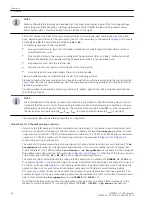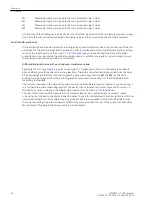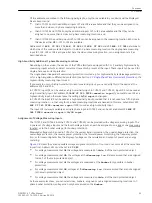
The auxiliary inputs can be assigned to a side or a measuring location, or they can remain non-assigned. If you
have assigned exactly one measuring location to a side, this side is equivalent to the measuring location.
Single-phase auxiliary measured currents are used in the following cases:
•
In differential protection, to include the starpoint current of an earthed transformer winding (either
directly or via a neutral earthing reactor in the protected zone);
•
In restricted earth fault protection, to compare the starpoint current of an earthed winding (transformer,
generator, motor, shunt reactor, neutral earthing reactor) with the zero sequence current from the phase
currents;
•
In earth fault overcurrent protection, to detect the earth fault current of an earthed winding or neutral
earthing reactor;
•
In single-phase overcurrent protection, to detect any 1-phase current ;
•
For operational limit monitoring tasks and/or display of measured values.
•
1st case: It is essential to assign the 1-phase input to that side of the main protected object whose
incoming phase currents are to be compared with the earth fault current. Make sure that you assign the
1-phase input to the correct side. In case of transformers, this can only be a side with an earthed star-
point (directly or via a neutral earthing transformer in the protected zone).
In the example shown in
, the auxiliary measuring location X3 must be assigned to side S1.
Once the device has been “informed” of this assignment, the current measured at current input
Ι
X3 will
be reliably interpreted as the current flowing to the starpoint of the high-voltage winding (side 1).
In the example shown in
the additional measuring location X3 must be assigned to the
common winding. This winding, however, has 2 sides with 2 three-phase measuring locations. X3 is
assigned to side S1. Since the device has been informed in address 105
PROT. OBJECT
=
Auto-
transf.
that the protected object is an auto-transformer, and via the assignment of sides 1 and 2 that
these belong to the common winding, it is obvious that X3 belongs to the common winding, and that it is
therefore assigned to sides S1 and S2. The result is the same if X3 is assigned to side S2. For the auto-
transformer, it is therefore irrelevant which voltage side of the common winding (start of winding or any
tap) the starpoint current is assigned to.
•
2nd case: For this case, the same considerations apply as for the 1st case. In the case of generators,
motors or shunt reactors, select the terminal side. You can also use in the 2nd case a measuring location
that is not assigned to the main protected object. In the example shown in
, you can use the
restricted earth fault protection for the neutral reactor: The auxiliary measuring location X4 is in this case
assigned to the measuring location M5. This informs the device that the measured values of the non-
assigned measuring location M5 (3-phase) must be compared with the measured value of the additional
measuring location X4 (1-phase).
•
3rd case: Here again, the auxiliary measuring location must be assigned to that side whose earth fault
current is to be processed. You can also use a measuring location that is not assigned to the main
protected object. Please note that this auxiliary measuring location will provide not only the measured
value for the earth fault overcurrent protection but also circuit breaker information (current flow and
manual-close detection) from the corresponding 3-phase measuring location.
One can also proceed as described in cases 4 and 5, if the current used by the earth fault overcurrent
protection cannot be assigned to a specific side or 3-phase measuring location.
•
4th and 5th case: In these cases you set the parameter for the assignment of the auxiliary measuring
location to
conn/not assig.
(connected but not assigned). The auxiliary measuring location is then
assigned to neither a specific side of the main protected object nor to any other 3-phase measuring loca-
tion. These protection and measuring functions do not need any information on their assignment to a 3-
phase measuring location because they only process 1-phase currents.
•
General advice: If you want to use a 1-phase auxiliary measuring location both for a function as per the
3rd to 5th case and for the 1st or 2nd case, you must of course assign it as described in the 1st and 2nd
case.
If the device is equipped with a 1-phase measuring input but you do not need it, leave the setting
Not
connected
unchanged (not connected).
Functions
2.1 General
52
SIPROTEC 4, 7UT6x, Manual
C53000-G1176-C230-5, Edition 09.2016
Summary of Contents for SIPROTEC 4 7UT6 Series
Page 394: ...394 SIPROTEC 4 7UT6x Manual C53000 G1176 C230 5 Edition 09 2016 ...
Page 482: ...482 SIPROTEC 4 7UT6x Manual C53000 G1176 C230 5 Edition 09 2016 ...
Page 504: ...504 SIPROTEC 4 7UT6x Manual C53000 G1176 C230 5 Edition 09 2016 ...
Page 522: ...522 SIPROTEC 4 7UT6x Manual C53000 G1176 C230 5 Edition 09 2016 ...
Page 528: ...528 SIPROTEC 4 7UT6x Manual C53000 G1176 C230 5 Edition 09 2016 ...
Page 538: ...538 SIPROTEC 4 7UT6x Manual C53000 G1176 C230 5 Edition 09 2016 ...
Page 664: ...664 SIPROTEC 4 7UT6x Manual C53000 G1176 C230 5 Edition 09 2016 ...
Page 666: ...666 SIPROTEC 4 7UT6x Manual C53000 G1176 C230 5 Edition 09 2016 ...
Page 684: ...684 SIPROTEC 4 7UT6x Manual C53000 G1176 C230 5 Edition 09 2016 ...














































